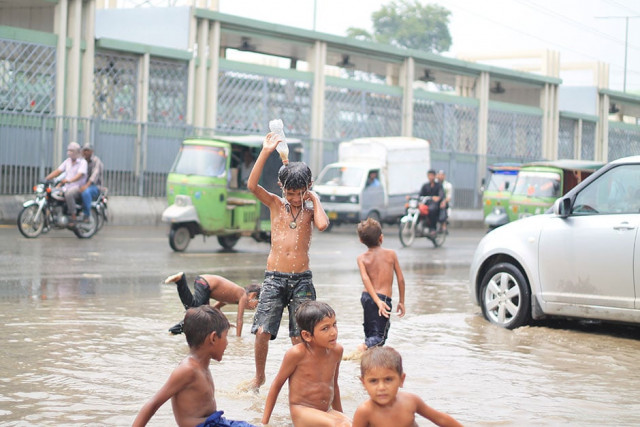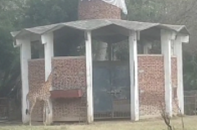Is Pakistan ready to run out of water?
Population growth, migration and business activity have contributed to increased water demand

PHOTO: WWF-PAKISTAN
Formidable challenges
Pakistan now stands fourth among the world's top ten water insecure countries according to the 2010 water security risk index. Rapid population growth, unchecked migration and the establishment of several industries have contributed to increased water demand.
According to estimates, Pakistan’s requirement for drinking water will stand at 135 Million Acre Feet (MAF) by 2025, outstripping water availability by 31 MAF. Already, water tables in Islamabad and Lahore have dropped to 50 and 20 feet respectively.
Water scarcity ‘biggest threat’ to Pakistan
 PHOTO: WWF-PAKISTAN
PHOTO: WWF-PAKISTAN PHOTO: WWF-PAKISTAN
PHOTO: WWF-PAKISTANBusiness activity and water woes
Continued industrial growth has placed immense pressure on the nation's water resources. Statistics released by WWF-Pakistan show that the textile sector constitutes 20 per cent of total industries in Pakistan and accounts for 69 per cent of total industrial water consumption.
Water scarcity ‘biggest threat’ to Pakistan
Lahore alone has 2,700 registered industries. Of these, 75 per cent are large-scale factories, the main consumers of groundwater. The water table depth in central Lahore has decreased to 40 metres and is expected to drop below 70 metres by 2025.
 PHOTO: WWF-PAKISTAN
PHOTO: WWF-PAKISTAN PHOTO: WWF-PAKISTAN
PHOTO: WWF-PAKISTANAs a result of these large-scale industries, industrial waste presents a growing concern. The entire municipal waste of Lahore is collected through 14 main drains and discharged into River Ravi untreated. Industrial waste is also is directly discharged into canals by 271 industrial units.
"Only eight per cent of municipal sewage is treated. Likewise 2,000 million gallons of sewage is discharged to surface water bodies and less than one per cent of wastewater is treated by industries. In 11 cities of Punjab, over two million people drink unsafe water with high levels of arsenic," a WWF-Pakistan study revealed.
 PHOTO: WWF-PAKISTAN
PHOTO: WWF-PAKISTAN PHOTO: WWF-PAKISTAN
PHOTO: WWF-PAKISTANThe chemical, food processing, pulp and paper, poultry, dairy, plastics, paint, pesticides, leather, tannery and pharmaceutical industries are also responsible for water pollution. According to estimates, approximately 730 tons of Biological Oxygen Demand (BOD) load is added to River Ravi per day. This is the amount of dissolved oxygen needed by micro-organisms to break down organic material present in any water body.
These industries also tend to face reputation, physical and regulatory risks owing to water scarcity. Physical risks directly impact business activity, raw material supply, intermediate supply chain and product use due to water scarcity.
 PHOTO: WWF-PAKISTAN
PHOTO: WWF-PAKISTAN PHOTO: WWF-PAKISTAN
PHOTO: WWF-PAKISTANPakistan also ranks fourth among the world's top 10 countries in terms of water withdrawal and tops the list of countries for water intensity rate (the amount of water, in cubic meters, used per unit of GDP). A report published by the Gravity Recovery and Climate Experiment (GRACE) satellite mission of NASA revealed that the Indus Basin aquifer in northwestern India and Pakistan is the word's second most over-stressed.
 PHOTO: WWF-PAKISTAN
PHOTO: WWF-PAKISTAN PHOTO: WWF-PAKISTAN
PHOTO: WWF-PAKISTANThe absence of of laws on water rights is also resulting in pumping of groundwater by private housing schemes and industries. In Lahore alone, unregulated groundwater extraction is causing a drastic lowering of the groundwater table depth. In 1987, the depth of water table ranged from 8 to 20 metres. This dropped to 51 metres in 2011.
Corrective measures
In an attempt to promote a more sustainable future, rainwater harvesting is encouraged across all housing schemes in areas under the Water and Sewer Authority's (WASA) jurisdiction. Industries should monitor water resources and continue developing strategies to maintain water reserves. Furthermore, they should invest in treating wastewater at source and reuse it. The use of freshwater in the textile sector, which accounts for 72 per cent of total water used, can be reduced by 30 to 50 with modernisation techniques.
 PHOTO: WWF-PAKISTAN
PHOTO: WWF-PAKISTAN PHOTO: WWF-PAKISTAN
PHOTO: WWF-PAKISTANIt is vital for us to address the importance of water conservation in order to tackle the environmental concerns of global textile buyers. It is important that communities and businesses change their water consumption practices for a sustainable future. Water recycling should become an integral part of our lifestyles at every level and population control should also be incorporated in the process, since a growing population exerts immense pressure on natural resources.
WWF-Pakistan is establishing a city-wide partnership to bring different stakeholders on a single platform, develop an understanding of water issues, analyse them and formulate integrated strategies to mitigate them.



















COMMENTS
Comments are moderated and generally will be posted if they are on-topic and not abusive.
For more information, please see our Comments FAQ